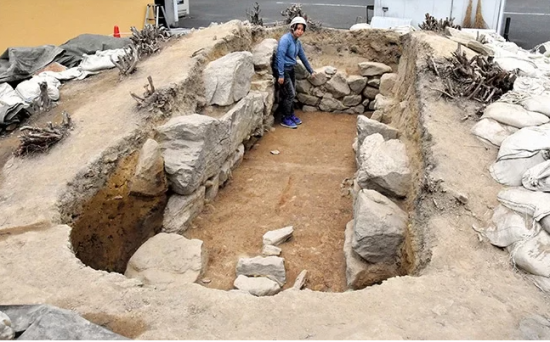Yuya Tanaka
Source - http://www.asahi.com/ajw/articles/AJ201607140047.html
 The shackle of an "ebijo" padlock dating back to the late seventh century recently uncovered in Asuka, Nara Prefecture (Shinnosuke Ito)
The shackle of an "ebijo" padlock dating back to the late seventh century recently uncovered in Asuka, Nara Prefecture (Shinnosuke Ito)
A government official likely dropped himself in it when he dropped a valuable padlock into a palace canal--more than 1,300 years ago.
“The padlock was covered with lacquer used for decorations, suggesting that it was an important lock used in the palace near the pond,” said Akira Yamanaka, professor emeritus of archeology at Mie University. “Perhaps a bureaucrat of the time dropped it by mistake. I bet he was reprimanded for it.”
A component of the padlock was recovered at the Asukakyo Ato Enchi ruins in Nara Prefecture’s Asuka village, the Archaeological Institute of Kashihara, Nara Prefecture, announced July 13.
The site features remnants of artificial ponds and is believed to be Japan’s first major garden built at an imperial palace. The artifact dating back to the late seventh century was found where an irrigation canal was once located just north of the northern pond.
The recovered metal component is believed to be the shackle for a type of ancient padlock known as “ebijo” (shrimp or prawn padlock) and is one of the oldest of its kind found in Japan. Such padlocks were used to secure latches on doors and gates at the time.
The device is locked by pushing the spring on the shackle into the lock body. To unlock it, a key is inserted to tighten the spring until the shackle is dislodged from the lock body.
Ebijo gets its name from the shape of the shackle, which resembles a prawn.
The shackle measures 9.5 centimeters in length and weighs about 17 grams. It was found relatively intact, most likely because it was preserved in a highly moist layer of clay. The surface of the component is lacquered and decorated with ornamental lines.
“The padlock was likely used to lock the doors of the palace or chests for the nobles to keep their garments in,” an expert said.
A lock body of an ebijo was found at the site in 1968.
Similar padlocks dating back to the Asuka Period (late sixth century-early eighth century) have also been uncovered from the Asuka Ike Kobo ruins in the village and Nonoue ruins in Habikino, Osaka Prefecture, according to the institute.
The ebijo padlock is believed to have been brought to Japan from China and the Korean Peninsula around that time period.
They are still used on doors and gates of traditional buildings, including many shrines and temples.